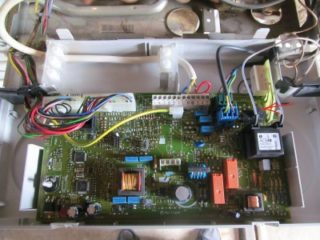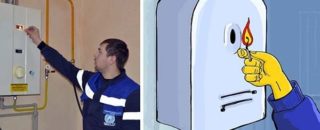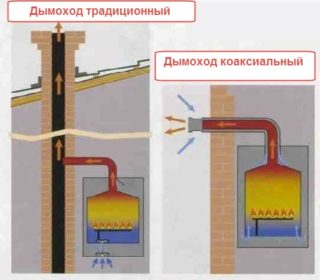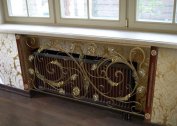Wall-mounted gas heating boilers are a good budget option for private houses and apartments, since they do not cause problems during installation and operation. Despite the long service life, most units fail from time to time. The most common problem is burner attenuation, but sometimes it’s difficult to understand the cause of the problem. In most cases, the owner of the boiler is able to fix the malfunction on his own. It is worthwhile to study in advance the most common causes of problems and find out what you can do in each case.
Why the boiler does not turn on
After proper installation in the absence of violations, the wall-mounted boiler usually does not cause problems to its owners. The average life of the unit is from 4 to 9 years, but breakdowns can occur at any stage of operation. When the wall-mounted boiler does not turn on, an error information appears on its display with an personal code or number, depending on the specific model of the device.
It must be written down and see the exact value in the instructions, which provide descriptions of the most common faults. The most common problem is the lack of ignition of a gas-air mixture. The flame may light up and go out after a while or be completely absent if the boiler closes the gas supply valve. This occurs for a number of reasons:
- problems with polarity of connection or phasing error;
- oxidation or contamination of the ignition electrode, the presence of a gap in the burner;
- cracks or breakdowns in the insulating part of high-voltage wires;
- difficulties with connecting electricity;
- lack of gas supply due to a faulty meter or dirty filters;
- broken control board.
Another popular problem is lack of traction. In this situation, the combustion products are not completely eliminated, the boiler for heating does not turn on and does not carry out ignition. In addition, often there are difficulties with water pressure, which normally should be at a minimum mark and controlled by a personal sensor. Users can control the pressure level with the built-in pressure gauge of mechanical or electronic type.
All gas boilers operate in a closed heating system, in which the pressure periodically drops. If it drops to a critical level of 0.5-0.7 bar, the device will not start, since the sensor detects the problem as a breakdown and stops the entire operation of the device.
The boiler may not work only in one mode, for example, hot water or heating. In such a situation, the unit requires a complete diagnosis from a specialist who will be able to accurately determine the cause of the failure.
Simple malfunctions can be eliminated at home on your own, in more complex cases it is better to entrust this work to a professional. According to the safety rules, it is forbidden to independently change parts, turn off individual elements if the heating boiler does not ignite for unknown reasons.
How to solve the problem
If the boiler does not work, for starters it is extremely important to prevent potential emergencies. To do this, the device is disconnected from the mains and completely shut off the gas valve, then an initial visual inspection is carried out and the boiler is checked for blockages or mechanical damage.After a sudden shutdown, it is not recommended to light the unit immediately.
If there is an open combustion chamber, you need to light a match or a lighter and keep them as close as possible to the holes with which air enters the burner itself. When the draft is not very clogged, the tongue will begin to deviate towards the main holes, and the fire will continue to burn at an acceptable level. A slight deflection of the flame indicates clogging.
A malfunction can be detected even at the stage of operation of the boiler: if it buzzes excessively and the flame does not have a shade, then the draft is too powerful, it must be reduced.
When the gas boiler does not turn on at all and is not able to give out any flame, they check the connection, the operation of the outlet and the integrity of the electrical wiring, since the cause of the malfunction may be problems with the power supply network. Burner nozzle clogging is also eliminated on its own. They are cleaned, determining clogging by the color of the flame, which should normally be a blue hue.
Often the boiler does not function due to low pressure in the common gas pipeline network, therefore it is better to additionally find out information about a potential accident in the gas service.
Gas equipment is classified as a high hazard device. If the wick suddenly goes out in a hot boiler, the device does not heat up or cannot turn on even after several attempts, emergency measures must be taken. The device is completely turned off, the room is checked for gas and carefully ventilated.
You can understand the degree of difficulty of the problem after testing the traction and examining the error number on the device screen.
Why does the burner go out?
A burner is a metal part in the form of a pipe with various nozzles, through which gas is supplied, which is combusted in air pumped in a special chamber. When you turn on and during operation, a mixture of carbon monoxide and carbon dioxide, as well as soot with water vapor. These combustion products are brought out. Uniform distribution of gas is achieved through a system of nozzles, air is injected using natural draft.
The fuel supply is blocked by the automation of the device in such cases:
- in the chimney draft is reduced or completely lost;
- gas pressure in the supply line drops below normal;
- the flame of the burner itself goes out due to the impossibility of removing combustion products.
Auto shutdown sometimes occurs due to external reasons or because of a generator breakdown. Such problems are less often encountered by owners of non-volatile devices of a simple design. Modern wall-mounted boilers with a closed combustion chamber often themselves turn off the fuel supply in a number of situations. This occurs when the flow sensor is triggered due to the stop of the movement of the heat carrier in the heating system, the air supply is reduced or completely stopped.
Power surges and power outages in the home network can also cause problems with the boiler. If the unit has become worse to carry out heating or does not work in one of the modes, you need to pay attention to such signals.
To prevent the boiler from shutting down during operation or at the wrong time, the device must be inspected more often for malfunctions. This work is best trusted by a specialist who can identify even complex problems at an early stage.
Other problems of gas boilers
Almost all wall-mounted boilers are equipped with a panel with a screen or indicators, as well as a control board. If there is no indication, make sure that the boiler is connected to a source of electricity. Connection is checked using a multimeter in the place where the board is connected to the device. When there is no voltage, you can try reconnecting the device.Additionally pay attention to the place where the fuses are located. In standard units, they are located on the board itself or in the connection area.
If everything is in order with the fuses, the voltage in the control zones remains at 220 volts, it is worth checking the control electronics and the gas generator. When the fuses blow, they test the operation of the pump, priority valve, fan, and instrument wiring for a short circuit. It is recommended to change the blown fuses and check the operation of the boiler again. There are situations when parts burn out again immediately after replacement, then it is worthwhile to turn off the high-voltage sections of the boiler in order to identify problem areas.
The device board may malfunction after water has entered. This occurs in the event of leaks and condensation inside the protective housing. Most often, water gets there by wire. Such damage cannot be repaired; on a failed board there will be characteristic oxidations and stains. The broken part is changed and the operability of the entire system is checked to prevent breakdowns in the near future.
It is important to prevent problems in time and call specialists for routine check of the device several times a year.







